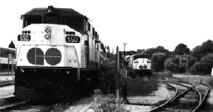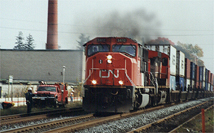Frequencies
This is what you have come for - the frequencies!
First, a little review. This is covered in other sections, but is
worth another look.
Railway communications typically take place
in three frequency bands. The main band is located in the VHF-hi band,
between 159.810 MHz and 161.565 MHz, spaced in 15 KHz increments. Railway communications
can also be found in the 400 MHz UHF band, carrying both voice and data
for various applications. In some cases and applications, you can find
railways using the 800-900 MHz band for various uses. For the most part,
you'll find most communications in VHF and UHF.
 For a good list of North America's railroad frequency
allocations, visit the Railroad
Radio site by clicking on the signal head! For a good list of North America's railroad frequency
allocations, visit the Railroad
Radio site by clicking on the signal head!
 A train's EOT (End of Train) devices operate on two
specifically designated frequencies: 452.9375MHz and 457.9375 MHz. As it was
stated elsewhere in this website, these are handy for tracking trains that are
out of sight (around a bend, in the distance, etc.) If a train is within
about a kilometer, you can hear the squawks of the EOT system communicating with
itself. The system sends out a transmission every 30 seconds or so. A train's EOT (End of Train) devices operate on two
specifically designated frequencies: 452.9375MHz and 457.9375 MHz. As it was
stated elsewhere in this website, these are handy for tracking trains that are
out of sight (around a bend, in the distance, etc.) If a train is within
about a kilometer, you can hear the squawks of the EOT system communicating with
itself. The system sends out a transmission every 30 seconds or so.
Also note - Canadian Railroads don't use all of the allocated frequencies - each railroad is allocated
specific channels by
the AAR.

Canadian National Railway
| CH |
AAR |
Frequency
(MHz) |
Description |
| 1 |
87 |
161.415 |
Road Channel - End to end |
| 2 |
73 |
161.205 |
Dispatcher |
| 3 |
55 |
160.935 |
Dispatcher (AI Toronto) |
| 4 |
37 |
160.665 |
Dispatcher (YB Toronto) |
| 5 |
17 |
160.365 |
Dispatcher |
| 6 |
25 |
160.485 |
Dispatcher |
| 7 |
2 |
159.810 |
Dispatcher |
| 8 |
61 |
161.025 |
Dispatcher (YA Toronto) |
| 20 |
45 |
160.785 |
MoW (Maintenance of Way) & Engineering |
| 81 |
23 |
160.455 |
MoW/Engineering |
| 82 |
7 |
160.215 |
MoW/Engineering |
| 83 |
27 |
160.515 |
MoW/Engineering |
| 84 |
11 |
160.275 |
MoW/Engineering |
| 85 |
19 |
160.395 |
Maple Hump Yard (Mac Yard) |
| xx |
68 |
161.130 |
Windsor Tunnel |
| xx |
75 |
161.235 |
CN Police |
GExR
Goderich & Exeter
Railway
| CH |
AAR |
Frequency
(MHz) |
Description |
| 1 |
80 |
161.310 |
All Communications |

St. Lawrence & Hudson
Railway
Important Note about CP Rail frequencies:
It took me a while to figure this out - and I kind of
understand it, so if you are totally confused by the end of this section,
you aren't alone. Anyways, here goes: In order to call RTC, trains must
switch to the call-in channel, hit their PTT button on their radios five
times in a second, wait for some answerback tones, and switch back to the
Train Standby to wait for the dispatcher. The call-in frequencies are
unique married pairs to the train standby channels. It may appear that
channels 3,6,8,9 are the same (160.425 MHz) - until one realizes they are duplex
channels, in that they have different input and output frequencies. The
input frequencies in these channels are the different, but the output is
the same as the Train Standby frequency in which they are associated with.
This means that you don't need to put the call-in frequencies into their
scanners - they can hear everything that goes on just by listening
to the Train Standby channel. Besides, all that goes on on the RTC call-in
are beeps and clicks, so its not really worth the bother of entering them
- I've posted them here
just for completion's sake.
I've included a subdivision-specific table first, and then a complete list
of frequencies afterwards.
| Subdivision-specific
Frequency Table |
| CH |
AAR |
Frequencies
(MHz) |
Description |
| 1/3 |
91/21 |
Train Standby (1)
161.475
RTC Call-in (3)
160.425 |
Havelock Subdivision
Nephton Subdivision
Canpa Subdivision
Owen Sound Subdivision
Galt Subdivision (mile 0-40) |
| 4/9 |
67/21 |
Train Standby (4)
161.115
RTC Call-in (9)
160.425 |
Belleville Subdivision (mp
195-211)
North Toronto Subdivision
Mactier Subdivision (mile 0-22) |
| 5/6 |
81/21 |
Train Standby (5)
161.325
RTC Call-in (6)
160.425 |
Galt Subdivision (mile 40-114) |
| 7/8 |
95/21 |
Train Standby (7)
161.535
RTC Call-in (8)
160.425 |
Belleville subdivision (mile
0-195)
Mactier subdivision (north of mp 22) |
| 82/6 |
47/81 |
Train Standby
160.815
RTC Call-in
161.325 |
Hamilton
subdivision |
| Complete
frequency table |
| CP |
Frequency |
Description |
Subdivisions |
| 1 |
161.475 |
Train standby |
|
| 2 |
161.535/161.475 |
RTC call-in |
|
| 3 |
160.425/161.475 |
RTC call-in |
|
| 4 |
161.115 |
Train standby |
|
| 5 |
161.325 |
Train standby |
See
Above Table |
| 6 |
160.425/161.325 |
RTC call-in |
|
| 7 |
161.535 |
Train standby |
|
| 8 |
160.425/161.535 |
RTC call-in |
|
| 9 |
160.425/161.115 |
RTC call-in |
|
| 10 |
160.425/160.725 |
RTC call-in |
|
| 11 |
160.845 |
MoW 2 |
Hamilton |
| 12 |
160.335/160.845 |
Utility 1 |
Hamilton |
| 13 |
161.175 |
MoW 1 |
Belleville, N.Toronto,
Owen Sound, Havelock, Nephton, Mactier |
| 14 |
160.335/161.175 |
Utility 2 |
N.Toronto, Mactier |
| 15 |
160.245/160.845 |
Utility 3 |
|
| 16 |
161.265 |
MoW 3 |
Belleville |
| 17 |
160.245/161.265 |
Utility 4 |
Belleville |
| 18 |
160.635/161.175 |
Utility 5 |
|
| 19 |
161.505 |
MoW 4 |
Canpa, Galt |
| 20 |
160.635/161.505 |
Utility 6 |
Canpa, Galt |
| 21 |
160.605/161.265 |
Utility 7 |
|
| 22 |
160.605/161.505 |
Utlity 8 |
|
| 23 |
160.245/161.505 |
Utility 9 |
|
| 25 |
160.425/161.100 |
RTC call-in |
|

GO Transit
Note: During rail operations, GO Trains use existing CN/CP
frequencies for all communications.
| 419.4375 |
Willowbrook Yard |
| 413.9375 |
Commuter Central tx |
| 418.9375 |
Commuter Central rx |

VIA Rail Canada
Note: During rail operations, VIA trains use existing CN/CP frequencies
for all communications.
All channels below are repeaters. Frequencies listed are output
channels, which will carry both sides of the conversation.
| 457.0625 |
Toronto Maintenance |
| 457.3625 |
Toronto Maintenance |
| 452.0625 |
Toronto Maintenance |
| 452.3625 |
Toronto Maintenance |
| 459.2250 |
Toronto Maintenance |
| 466.2125 |
Toronto Union Station |
| 467.8250 |
Toronto Maintenance |
| 468.8500 |
Toronto Maintenance |
| 468.9625 |
Toronto Maintenance |
| 461.2125 |
Stationmaster arr/dep |
| 462.8250 |
Toronto Maintenance |
| 463.8500 |
Toronto Maintenance |
| 463.9625 |
Toronto Maintenance |
| 461.0125 |
Security |
| 461.2125 |
Stationmaster
arrival/departures |
|